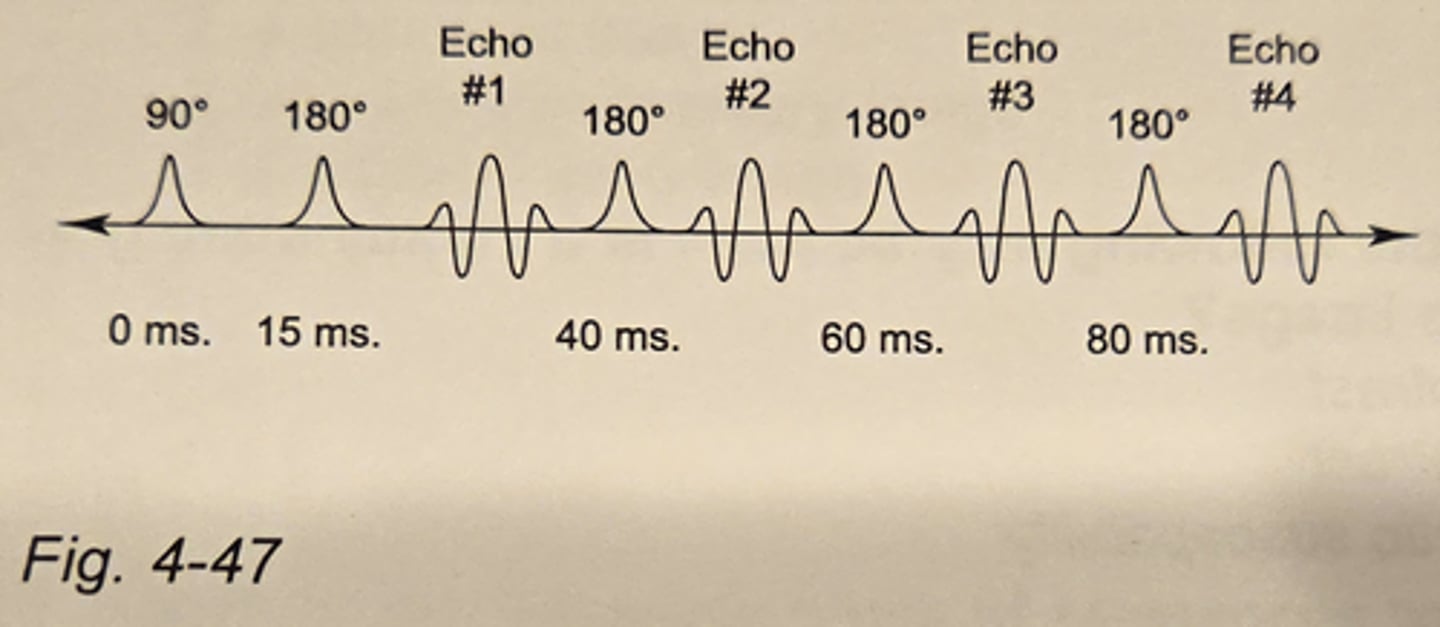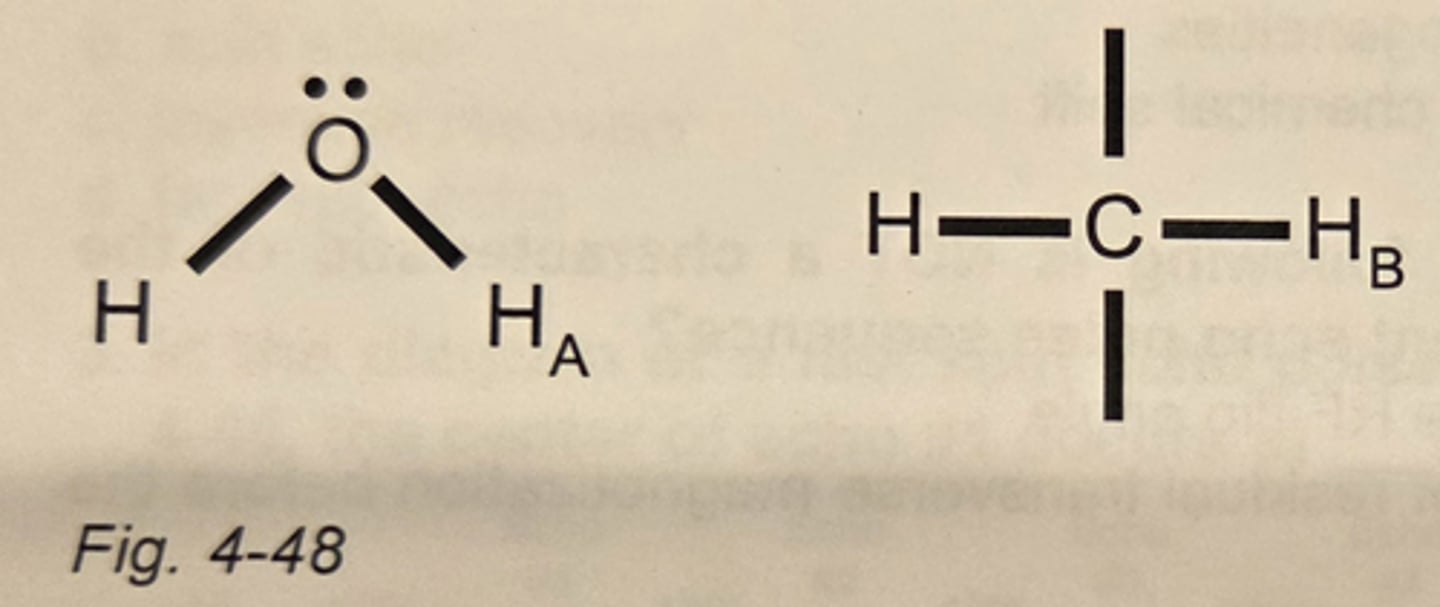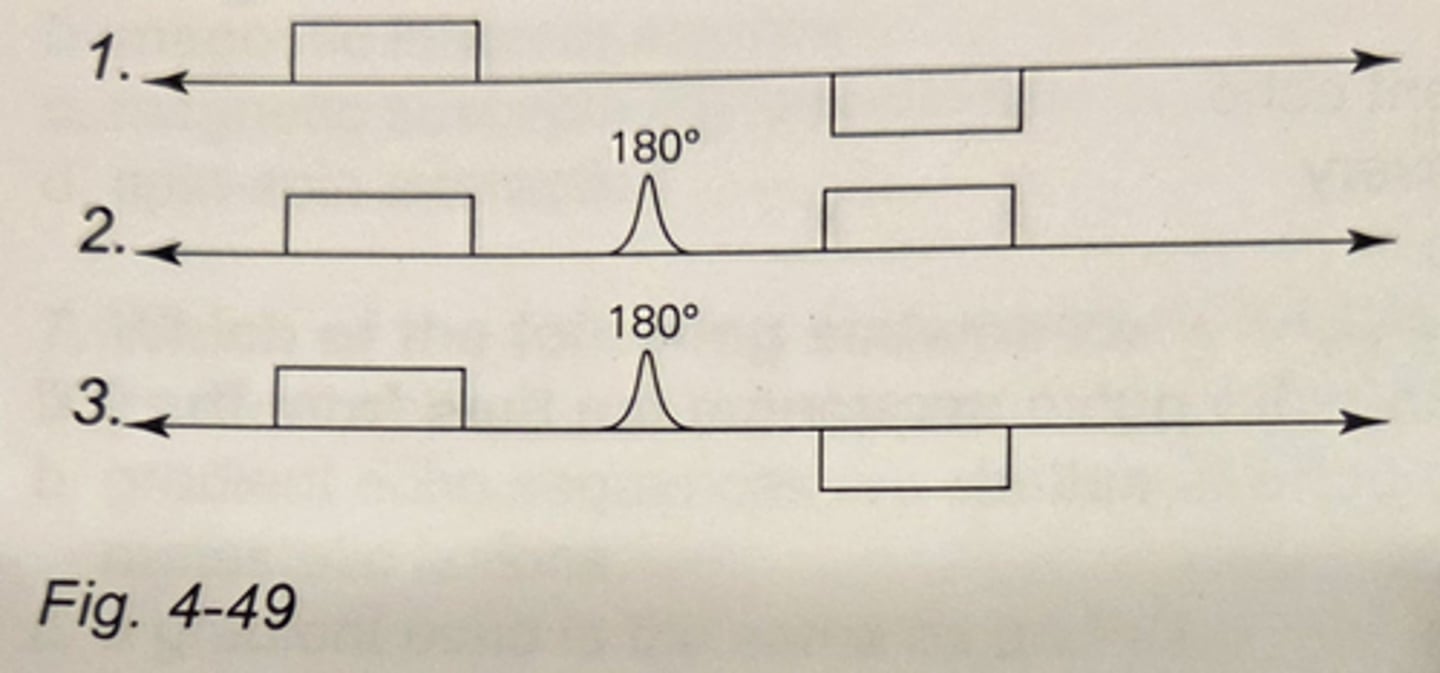Test 4: MRI Pulse Sequences
1/39
There's no tags or description
Looks like no tags are added yet.
Name | Mastery | Learn | Test | Matching | Spaced |
|---|
No study sessions yet.
40 Terms
Which of the following may be T1-weighted
1. a spin echo image
2. an inversion recovery
3. a gradient echo image
1, 2 & 3
3 multiple choice options
Which of the following types of sequences was most likely used to generate the image in Fig. 4-43?
gradient echo
3 multiple choice options

In the diagram of a fast spin echo pulse sequence in Fig. 4-44, the center of echo #1 occurs at _____ms.
30
3 multiple choice options

Which of the following RF flip angles would result in the largest transverse component, assuming the net magnetization is initially in the longitudinal direction?
75°
3 multiple choice options
Which of the following is NOT related to the receiver bandwidth?
the range of frequencies transmitted to select the slice thickness
3 multiple choice options
Which of the following is NOT included in the T2* contrast?
spin-lattice relaxation
3 multiple choice options
Which of the following statements is FALSE?
a gradient echo is the same as an FID
3 multiple choice options
Consider the dual contrast spin echo pulse sequence shown in Fig. 4-45 in which the 90° RF pulse is applied at time = 0, the center of the first echo forms at time = 15ms, and the center of the second echo forms at time - 90ms. The 180° RF pulse to form the echo used for the T2-weighted image must have been applied at _____ms.
52.5
3 multiple choice options

The _______________ pulse sequences use the least amount of RF energy.
spoiled gradient echo
3 multiple choice options
If the TI of an inversion recovery pulse sequence is chosen such that the magnetization of silicone, from a silicone breast implant, is relaxing through zero when the 90° RF pulse is transmitted, what type of signal can be expected from the silicone in the resulting image?
dark
3 multiple choice options
In the conventional spin echo pulse sequence with a TE of 20 ms and an echo duration of 5ms shown in Fig. 4-46, the receiver must turn on _____ms after the center of the 180° pulse.
7.5
3 multiple choice options

A 180° RF pulse followed by a 90° RF pulse, followed by another 180° RF pulse is what type of pulse sequence?
inversion recovery
3 multiple choice options
In a fast spin echo pulse sequence, the time from the 90° pulse to the echo is called:
TE
3 multiple choice options
Which of the following may NOT be seen in a conventional spin echo image?
the phase effects of magnetic susceptibility
3 multiple choice options
Which of the following statements is FALSE regarding a gradient echo sequence?
a long TE improves the T1 contrast
3 multiple choice options
Because ____________________, the inversion recovery method of fat suppression should NOT be used with MR contrast agents.
the enhanced tissues as well as the fat may be suppressed
3 multiple choice options
As the TE of a gradient echo sequence is varied, __________ cause fat and water to have signal intensities which cycle from similar to different.
phase effects of chemical shift
3 multiple choice options
"An EPI sequence in which all of the echoes necessary to reconstruct the image are collected following a single RF excitation" is the definition of:
single-shot EPI
3 multiple choice options
Which of the following sequences is best for performing diffusion-weighted imaging?
echo planar imaging
3 multiple choice options
In a fast spin echo sequence with an echo train of 12, how many RF pulses are applied for a given slice, during one TR period?
13
3 multiple choice options
Which of the following may be seen in a steady state gradient echo image?
1. T1 contrast
2. T2 contrast
3. magnetic susceptibility
3 only
3 multiple choice options
Which of the following may be seen in a fast gradient echo image?
1. T1 contrast
2. T2 contrast
3. magnetic susceptibility
1 & 2
3 multiple choice options
Which of the following is NOT rephased by the 180° RF pulse in a spin echo pulse sequence?
spin-spin interactions
3 multiple choice options
Which of the following is NOT a characteristic of the spoiled gradient echo pulse sequence?
steady state transverse magnetization following the formation of the echo
3 multiple choice options
If a single echo was corrupted, due to a static discharge from the patient's wool socks, during the first 30 sec. of a 5 minute spin echo knee study, how would you expect the resultant image to appear?
there would be a stripe artifact throughout the entire image
3 multiple choice options
Which of the following types of pulse sequences would be the best choice for a cardiac perfusion study?
echo planar
3 multiple choice options
If you were running the fast spin echo pulse sequence shown in Fig. 4-47, and trying to obtain a set of T2-weighted images with TR=3000ms and TE=90ms, echo #_____ should be placed closest to the center of the rawdata.
4
3 multiple choice options

In a gradient echo pulse sequence, a system malfunction causes the first pulse of the readout gradient to remain on one millisecond too long. The gradient echo will:
form later than the selected TE
3 multiple choice options
Which of the following statements is TRUE of the hydrogen nuclei shown in Fig. 4-48?
1. HB experiences less electron shielding than HA
2. HA experiences a lower magnetic field than HB
3. HA has a greater frequency than HB
3 only
3 multiple choice options

In a fast spin echo pulse sequence with an echo train of 8, if the first four echoes contribute to a proton density image, and the last four echoes contribute to a T2-weighted image, how many repititions are required to fill the rawdata of a 256x256 T2-weighted image?
64
3 multiple choice options
Which of the combinations of gradient pulses shown in Fig. 4-49 will generate a net phase of zero?
1 & 2
3 multiple choice options

During a conventional 10 minute T2 spin echo scan with 1 signal average, most of the contrast information is collected for the image during:
minutes 5 and 6
3 multiple choice options
Consider a spin echo pulse sequence in which the 90° RF pulse is applied at time = 0 and the maximum signal of a spin echo forms at a time = 15 ms. The 180° pulse must have been applied at __________ms.
7.5
3 multiple choice options
____________________ is NOT a characteristic of the steady state gradient echo pulse sequence.
A 180° RF pulse
3 multiple choice options
Which of the following RF flip angles would result in the largest longitudinal component, assuming the net magnetization is initially in the longitudinal direction?
30°
3 multiple choice options
In an ideal tissue which experiences no spin-spin interactions which of the following statements is TRUE?
the amplitude of the magnetization originally placed into the transverse plane is greater than the amplitude of the gradient echo
3 multiple choice options
In a T2-prepared fast gradient echo sequence which uses a 90°, 180°, 90° preparation scheme, how many 90° RF pulses are applied for a single image with 192 phase steps in its matrix?
2
3 multiple choice options
What is the time from an inverting pulse to a 90° pulse called?
TI
3 multiple choice options
In which of the following pulse sequences would you expect to find the shortest TR?
gradient echo
3 multiple choice options
Which of the following statements is TRUE regarding a fast spin echo sequence with an echo train of 16 compared to a fast spin echo sequence with an echo train of 4, assuming both use the same TR and all the echoes are separated by 10ms, with the first echo at TE=30ms?
1. the sequence with an echo train of 4 should have a scan time of about 75% less than the one with an echo train of 16
2. the sequence with an echo train of 16 will be have better resolution than the sequence with an echo train of four
3. the sequence with an echo train of 16 will be lower in signal-to-noise ratio than the one with an echo train of four
3 only
3 multiple choice options